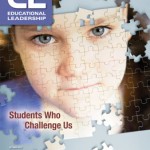 The October, 2012 issue of Educational Leadership, the flagship journal of the Association for Supervision and Curriculum Development (ASCD), in an issue dedicated to “Students Who Challenge Us,” features my article “First, Discover Their Strengths,” which highlights many of the ideas discussed in my forthcoming book Neurodiversity in the Classroom: Strength-Based Strategies to Help Students with Special Needs Achieve Success in School and Life (to be published in December, 2012 by ASCD).
The October, 2012 issue of Educational Leadership, the flagship journal of the Association for Supervision and Curriculum Development (ASCD), in an issue dedicated to “Students Who Challenge Us,” features my article “First, Discover Their Strengths,” which highlights many of the ideas discussed in my forthcoming book Neurodiversity in the Classroom: Strength-Based Strategies to Help Students with Special Needs Achieve Success in School and Life (to be published in December, 2012 by ASCD).
In the article (which you can read in its entirety online), I suggest that educators need to embrace a new perspective with regard to students with special needs: that we stop using the “disability” model, and begin embracing a “diversity” perspective in helping these kids achieve success in the classroom and beyond. I introduce the idea of neurodiversity, which has emerged from the autism community over the past decade, to provide a new approach to understanding students with disabilities. Neurodiversity suggests that we take the same celebratory attitude that we extend to biodiversity and cultural diversity, and apply it to students who have different ways of thinking and behaving in the classroom. A calla lily isn’t a flower with “petal deficit disorder.” We appreciate its beauty for its own sake. So many kids with special needs grow up with these labels: autism, ADHD, learning disabilities, dyslexia, intellectual disabilities, emotionally and behaviorally disordered. And while there may be diagnostic and administrative purposes to these labels, in the classroom, they focus the attention on what’s NOT working, instead of what IS working.
I propose in my article (and in my forthcoming book) that we employ an ecological paradigm when thinking about how to create strategies that help ensure success for students with special needs. In particular, I focus on the concept of “positive niche construction.” This is something that animals do in the wild to ensure their thriving. Beavers build dams, ants build ant hills, bees create bee hives, spiders spin webs. They are acting directly on the environment to change it into something that works for them.
Similarly, regular and special educators ought to create positive niches for students with special needs. I explore seven practical ways for educators to create these positive environments in the classroom:
- Strengths awareness (a deep knowledge of a student’s abilities)
- Positive role models (examples of people with disabilities who achieved success)
- Enriched human resources (a supportive network of individuals to help the student succeed)
- Affirmative career aspirations (an understanding of those careers whose requirements match the strengths of neurodiverse students)
- Assistive technologies and Universal Design for Learning (old and new technologies that help neurodiverse students sidestep obstacles to learning to get the job done)
- Environmental modifications (methods for changing the classroom or school space to take a neurodiverse student’s special needs into consideration)
- Key learning strategies (a wide range of specific methods for teaching a student in all subject areas that are based on their strengths instead of their weaknesses).
The article (and forthcoming book) explains in greater detail these seven components of enriching a student’s environment. The most important component of positive niche construction, I believe, is “Strengths Awareness.” We need to get better as educators (and parents) at discovering what’s RIGHT with our kids. In the article (and forthcoming book), I discuss some of the current research that looks into the strengths of students with autism, ADHD, learning disabilities, and other neurodiversities. Research tells us that students with autism are systemizers and have enhanced perceptual awareness, that students with ADHD have a proclivity for seeking novelty, that students with dyslexia often have superior three-dimensional visual-spatial abilities.
My hope for the article (and book) is that educators and parents will start to see students with special needs as ASSETS to their classrooms, not liabilities. And by building on these students’ strengths, we can really help them become who they were meant to be in life.
For more information about neurodiversity, see my book Neurodiversity in the Classroom: Strength-Based Strategies to Help Students with Special Needs Succeed in School and Life
This article was brought to you by Thomas Armstrong, Ph.D. and www.institute4learning.com.
Follow me on Twitter: @Dr_Armstrong



















